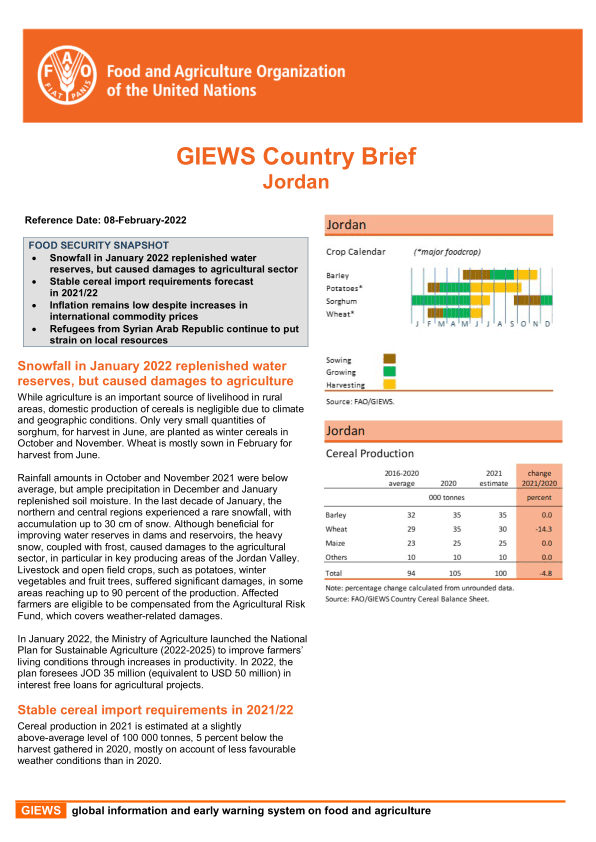FOOD SECURITY SNAPSHOT
• Snowfall in January 2022 replenished water reserves, but caused damages to agricultural sector
• Stable cereal import requirements forecast in 2021/22
• Inflation remains low despite increases in international commodity prices
• Refugees from Syrian Arab Republic continue to put strain on local resources
Snowfall in January 2022 replenished water reserves, but caused damages to agriculture
While agriculture is an important source of livelihood in rural areas, domestic production of cereals is negligible due to climate and geographic conditions. Only very small quantities of sorghum, for harvest in June, are planted as winter cereals in October and November. Wheat is mostly sown in February for harvest from June.
Rainfall amounts in October and November 2021 were below average, but ample precipitation in December and January replenished soil moisture. In the last decade of January, the northern and central regions experienced a rare snowfall, with accumulation up to 30 cm of snow. Although beneficial for improving water reserves in dams and reservoirs, the heavy snow, coupled with frost, caused damages to the agricultural sector, in particular in key producing areas of the Jordan Valley.
Livestock and open field crops, such as potatoes, winter vegetables and fruit trees, suffered significant damages, in some areas reaching up to 90 percent of the production. Affected farmers are eligible to be compensated from the Agricultural Risk Fund, which covers weather-related damages.
In January 2022, the Ministry of Agriculture launched the National Plan for Sustainable Agriculture (2022-2025) to improve farmers’ living conditions through increases in productivity. In 2022, the plan foresees JOD 35 million (equivalent to USD 50 million) in interest free loans for agricultural projects.
Stable cereal import requirements in 2021/22
Cereal production in 2021 is estimated at a slightly above-average level of 100 000 tonnes, 5 percent below the harvest gathered in 2020, mostly on account of less favourable weather conditions than in 2020.
Even in years with above-average domestic production, over 97 percent of the domestic cereal food and feed requirements are satisfied through imports. Cereal import requirements in the 2021/22 marketing year (July/June) are forecast at an average level of 3 million tonnes. Wheat and barley imports are usually sourced from the Black Sea Region given lower freight costs compared to other origins. The Government maintains strategic stocks (both in the country and in transit) aiming at covering up to 12 months of domestic consumption of wheat and about a one-month of consumption of rice and maize. In the future, to avoid market turbulences, the Government plans to stock up to two years for wheat for food consumption.
Price inflation remains low
The COVID-19 pandemic and the measures introduced to contain it disrupted in particular the tourism sector, which contributed to almost 20 percent of the gross domestic product (GDP) in 2019. Consequently, the economy contracted by 1.6 percent in 2020, but rebounded to a 2.2 percent growth in 2021. Unemployment rate increased to almost 25 percent in the second quarter of 2021, the highest level at least since 2005, up from the 19 percent before the start of the pandemic. About half of young people (between 16 and 25 years old) is unemployed.
In November 2021 (last information available), the annual food price inflation decreased by 0.6 percent, down from 5.2 percent recorded in March 2020, when households’ stockpiled food due to the lockdown at the onset of the COVID-19 pandemic. Overall inflation recorded an increase of 2.4 percent in December 2021, up from negative levels a year before. Despite moderate upticks in price inflation reflecting strengthening global commodity prices, the national currency pegged to US dollar has buffered larger domestic price increases.
Refugees from Syrian Arab Republic continue to put strain on local resources
According to the United Nations High Commissioner for Refugees (UNHCR), as of December 2021, almost 673 000 registered Syrian refugees were hosted in the country, mostly concentrated in Mafraq, Amman and Irbid governorates. This figure has not significantly changed since late 2016. Most of the refugees arrived between January and April 2013, when the conflict in the Syrian Arab Republic escalated. The World Food Programme (WFP) targets its programmes to assist the most vulnerable refugees through food vouchers across the country and through the provision of in-kind food distributions in the Zaatari Refugee Camp and some of the transit centres hosting refugees.
Since 2016, Syrian refugees have been permitted to work in agriculture, construction and manufacturing sectors. Since 2020, they are also allowed to work in the healthcare sector and, since last year, in all sectors open to non-Jordanians, assuming they secure a work permit. In 2021, a record number of 62 000 work permits was issued to Syrian refugees.


